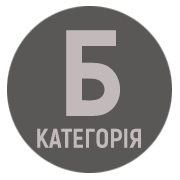Narrative videogame: types of verbal communication
DOI:
https://doi.org/10.32782/2617-3921.2021.19.121-134Keywords:
speech communication, non-verbal elements, computer game, narrative, game of mixed type, interactivity, information significanceAbstract
The present investigation is dedicated to studying different types of communication represented in videogames. The topicality of this research follows from the urgency of all lingual papers in the field of digital studies, on the one hand, and is stressed by the necessity to determine the role of verbal elements in computer games. The work is based on The Talos Principle, one of the most popular videogames of all times (as claimed by a wide number of ratings). The main objective of the paper is to single out the peculiarities of different communication types in the game studied. Thus, it presupposes setting the following tasks: considering the specific features of videogames as a type of human activity, contrasting them with films and literature, analysing the type and the idea of The Talos Principle game, distinguishing its genre and revealing the types of communication presented in it, together with their frequency and their importance for game-playing and its ludonarrative. The script of the game analysed counts over 14 thousand words, the game lasts about 5 hours. Having worked out a new taxonomy of videogames, the author argues that The Talos Principle belongs to narrative games, i.e. those telling a story, and classifies it as a game of mixed type from the point of view of its interactivity. The game story depends on the protagonist’s physical movements and activities, though they only help realise the goal of the game and solve puzzles. As any other game, The Talos Principle offers a gamer a new existence in a world built up by both verbal and non-verbal elements. A conclusion is made as to the equal shares by them and following from the nature of narrative videogames in general. Verbal elements in the game are represented by mono- and dialogical speech excerpts, letters and QR-codes. Non-verbal elements fall into sounds (soundtracks and sound imitation) and images; within the latter dynamic and static elements are singled out. The carried out investigation allows making a conclusion about information significance as a factor influencing the frequency of a certain type of message. Hence, as it is from the archives letters that the gamer gets the most important information for the game progress, this type of ranks first (23%) amongst other types of verbal communication.
References
Арутюнова Н.Д. Виды игровых действий. Логический анализ языка. Концептуальные поля игры. Москва : Индрик, 2005. С. 5–16.
Берн Э. Игры, в которые играют люди. Психология человеческих взаимоотношений. Люди, которые играют в игры. Психология человеческой судьбы / пер. с англ. Санкт-Петербург : Лениздат, 1992. 400 с.
Гегель Г.В.Ф. Сочинения. Лекции по эстетике. Собрание сочинений : в 14 т. 172 Т. 12. Кн. 1. Москва : Соцэкгиз ; Полиграфкнига, 1988. 472 с.
Ефимова Н.И., Моржанаев Н.И. Текст в компьютерной игре: филологический аспект. Вестник Марийского государственного университета. 2015. № 4(19). С. 75–78.
Кутлалиев Т.Х. Жанровая типология компьютерных игр: проблема систематизации художественных средств : aвтореф. дис. ... канд. культорологии. Москва, 2014. 25 с.
Лосев А.Ф. Мифология греков и римлян. Москва : Мысль, 1996. 975 с.
Морозова І.Б. Вербальний конфлікт як особлива мовленнєва тактика в діалозі. Мова: науково-теоретичний часопис з мовознавства. 2013. № 19. С. 30–33.
Морозова И.Б. Речевые механизмы успешного диалогизирования (на материале современного англоязычного художественного диалога). Науковий вісник Херсонського державного університету. Серія «Лінгвістика». 2013. Вип. ХХ. С. 128–134.
Морозова И.Б. Социальный гештальт личности сквозь призму речевого этикета. Науковий вісник Херсонського державного університету. Серія «Лінгвістика». 2017. Вип. ХХ. С. 123–136.
Морозова І.Б. Когнітивно-інтелектуальний рівень мовця крізь призму гештальт-аналізу. Актуальні проблеми функціонування мови і літератури в сучасному поліетнічному суспільстві : матеріали ІV Міжнародної науково-практичної конференції, м. Мелітополь, 27–28 вересня 2018 р. Мелітополь : МДПУ ім. Б. Хмельницького, 2018. С. 80–83.
Пожарицкая Е.А. Цифровая литература как интерактивная игра с читателем. Науковий вісник Східноєвропейського національного університету ім. Лесі Українки. Серія «Філологічні науки». 2016. № 6(331). С. 63−70.
Пожарицкая Е.А. Поиграем или почитаем? (Дигитальная литература: гносеологическая сущность и жанровое своеобразие). Матеріали наукової конференції на пошану 100-річчя зі дня народження професора А.К. Корсакова, м. Одеса, 31 жовтня 2016 р. Одеса : Букаєв В.В., 2016. С. 41–44. URL: http://onu.edu.ua/uk/structure/faculty/rgf/grameng/reporting-conference (дата звернення: 18.12.2020).
Пожарицкая Е.А. Особенности вербализации художественного произведения в романе и компьютерной игре: компаративный анализ. Тэарэтычныя і прыкладныя аспекты этналагічных даследаванняў : зборнік навуковых артыкулаў. Минск : БНТУ, 2019. С. 327–333.
Пожарицька О.О. Відеогра як синтез вербальних та невербальних інтерактивних дій користувача. Актуальні проблеми функціонування мови і літератури в сучасному поліетнічному суспільстві : матеріали ІV Міжнародної науково-практичної конференції, м. Мелітополь, 27–28 вересня 2018 р. Мелітополь : МДПУ ім. Б. Хмельницького, 2018. С. 179–183.
Попов О.А. Новая классификация компьютерных игр. Статистика в психологии и педагогике. 2009. URL: https://psystat.at.ua/publ/4-1-0-30 (дата звернення: 28.01.2021).
Принцип Талоса: Постскриптум. Зеркало блога о философе Стратоне из Стагира. URL: https://talosprinciple.wordpress.com/ (дата звернення: 18.12.2020).
Саяхова Д.К. Языковая локализация видеоигр: лингвокультурологический и когнитивно-прагматический аспекты : дис. ... канд. филол. наук. Уфа, 2021. 192 с.
Селютин А.А. Лингвистический конфликт людонарратива в сценариях компьютерных игр. Художественное произведение в современной культуре: творчество – исполнительство – гуманитарное знание : сборник статей и материалов. Челябинск : Южно-Уральский государственный институт искусств им. П.И. Чайковского, 2019. С. 202–205.
Мир поправимых ошибок (психология компьютерных игр) / А.Г. Шмелев и др. Компьютерные игры. 1988. С. 16–84.
Югай И.И. Компьютерная игра как жанр художественного творчества на рубеже XX-XXI веков : автореф. дис. ... канд. искусствоведения. Санкт-Петербург, 2008. 26 с.
Allin J. Croteam gets serious about philosophical first-person puzzler The Talos Principle. AdventureGamers. June 12, 2014. URL: https://adventuregamers.com/news/view/26602 (дата звернення: 01.03.2021).
Araújo Naiara Sales. Literature and Videogames: Adaptation and Reciprocity Revista Letras Raras. December 2017. 6(3):222. DOI: 10.35572/rlr.v6i3.872.
Best of 2014 – Awards. GameTrailers. 25 December 2014. URL: https://www.youtube.com/c/gametrailers.
Brown Alistair. Guest Blog: Are Video Games Literature? Durham University Blog. 2013. URL: https://interestingliterature.com/2013/08/guest-blog-are-video-games-literature/ (дата звернення: 28.01.2021).
Hocking C. Ludonarrative Dissonance in Bioshock. BioShock Presentation – IGDA. Montreal. URL: https://clicknothing.typepad.com/click_nothing/2007/10/ludonarrative-d.html (дата звернення: 23.02.2021).
Huizinga Johan. Homo Ludens: A Study of the Play-Element in Culture. NY : Angelico Press, 2016. 232 р.
Meyer Cole. Video Games and Literature. The Masters Review Blog. 6 November 2019. URL: https://mastersreview.com/video-games-and-literature/ (дата звернення: 23.02.2021).
Morozova I., Pozharytska О. Speech Roles and Games We Play. Institute of English Studies, School of Advanced Study. ISLE 5 – The 5th International Conference of the International Society for the Linguistics of English. London, United Kingdom, 17 − 21 July, 2018. Pp. 9-10
Morozova I., Pozharytska О. Books vs Video Games: A Gestalt Approach to the Future Narrative. ECAH2019 − The European Conference on Arts & Humanities. July 12-13. Brighton, United Kingdom, 2019. P. 11-12.
Pease A., Pease B. The definitive book of body language. Australia: Pease International, 2004. 386 p.
Pozharytska Olena. Computer Literature as a New Modus of the Readers’ Existence. Science and Education a New Dimension. Philology. IV (23).
Issue: 100. 2016. P. 27-32. URL: http://scaspee.com/all-materials/computer-literature-as-a-new-modus-of-the-readers-existence-pozharytska-o (дата звернення: 01.03.2021).
Roach Jacob, Hicks Michael. The best puzzle games of all time Digital Trends February 7, 2021. URL: https://www.digitaltrends.com/gaming/best-puzzle-games/ (дата звернення: 01.03.2021).
Suellentrop Chris. Enticing All to See the Bigger Picture. The New York Times. Jan. 27, 2015. URL: https://www.nytimes.com/2015/01/28/arts/video-games/the-talos-principle-prompts-thinking-beyond-virtual-world.html (дата звернення: 01.03.2021).
Walker John. The 25 best puzzle games ever made. Rock, Paper, Shotgun. Gamer Network Limited. 8 May, 2015. URL: https://www.rockpapershotgun.com/best-puzzle-games?page=4 (дата звернення: 01.03.2021).
Washenko Anna. The 10 best puzzle games for console, Android, iOS and PC. GamesRader+. Future US Inc. 31 May 2017. URL: https://www.gamesradar.com/best-puzzle-games/ (дата звернення: 01.03.2021).
Wolf Mark J. P. The Medium of the Video Game. Austin: University of Texas Press. 2001. 203 p.
The 100 Best Video Games of All Time. Slant Magazine. 13 April 2020. https://www.slantmagazine.com/games/the-100-best-video-games-of-all-time/ (дата звернення: 01.03.2021).
2015 Independent Games Festival announces Main Competition finalists. Gamasutra. 7 January 2015. URL: https://www.gamasutra.com/view/news/233641/2015_Independent_Games_Festival_announces_Main_Competition_finalists.php (дата звернення: 01.03.2021).



